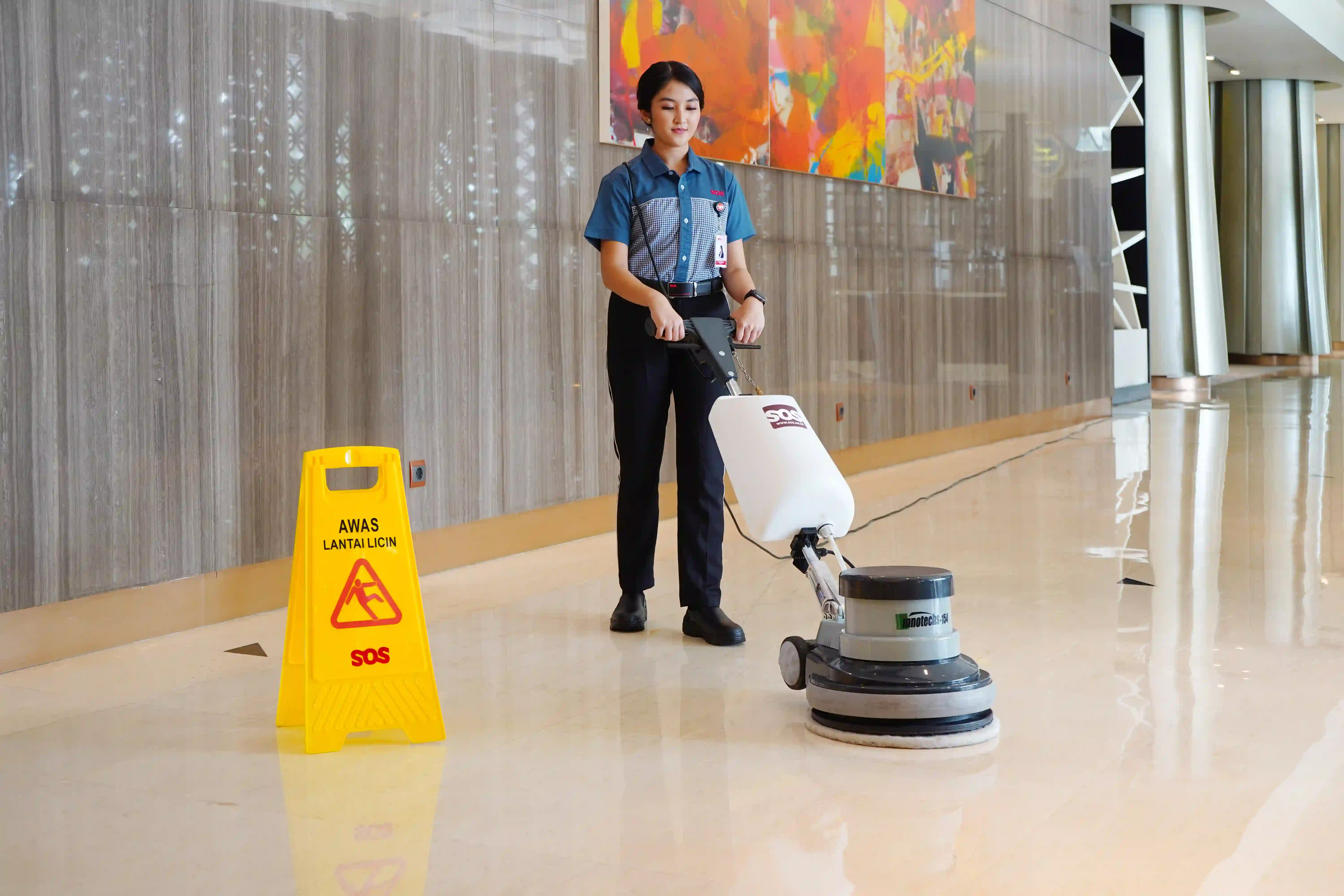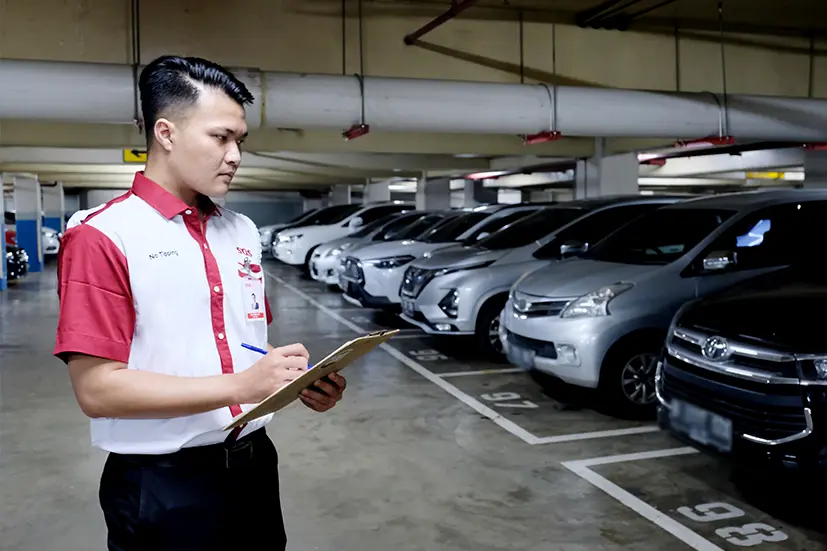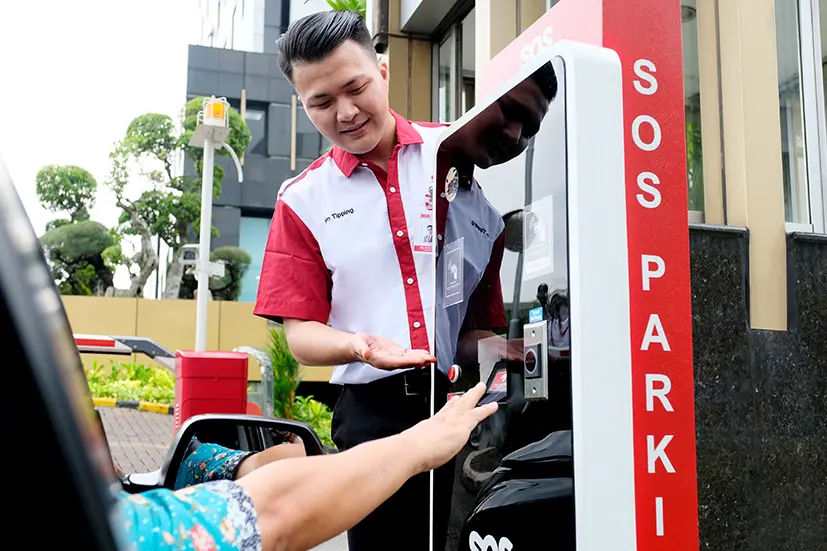4 Differences Between Cleaning, Sanitizing, and Disinfecting
24 October 2025

Knowing the difference between cleaning, sanitizing, and disinfecting is crucial in maintaining professional hygiene standards. Many people assume these terms mean the same thing, but in reality, each serves a different purpose and level of effectiveness in the cleaning process.
To apply them correctly, let’s explore in detail what distinguishes each one below.
What Is Cleaning?
Cleaning is the basic process of removing dirt, dust, and stains from surfaces to make them look tidy and well-maintained. This step does not kill germs, but it serves as the foundation before sanitizing or disinfecting takes place.
Cleaning process includes:
-
Using water, soap, or detergent to lift and remove dirt.
-
Applied on frequently used surfaces such as desks, floors, and office furniture.
-
Improves visual cleanliness and comfort in the workspace.
-
Should be done regularly to make sanitizing and disinfecting more effective.
What Is Sanitizing?
Sanitizing is the process of reducing the number of microorganisms on surfaces to a safe level according to health standards.
Unlike cleaning, this stage focuses on maintaining hygiene after physical dirt has been removed. Sanitizing implementation in office cleaning:
-
Uses mild cleaning solutions or alcohol-based liquids.
-
Applied on frequently touched areas such as door handles, desks, and elevator buttons.
-
Helps prevent germ transmission without damaging surfaces.
Read Also: 7 Office Cleaning Service Tasks for Maximum Cleanliness
What Is Disinfecting?
Disinfecting is the process of killing germs, bacteria, and viruses on surfaces using special chemical agents.
This stage follows cleaning and sanitizing to ensure the area is completely free from harmful microorganisms:
-
Using disinfectant liquids with concentrations that meet health standards.
-
Applied on high-risk areas such as toilets, sinks, and public spaces.
-
Requires specific contact time to ensure effectiveness.
-
Must be performed by professional cleaning staff with PPE according to K3 (Occupational Safety and Health) standards.
Key Differences Between Cleaning, Sanitizing, and Disinfecting?
Meskipun ketiganya sering dianggap sama, cleaning, sanitizing, dan disinfecting memiliki fungsi dan tujuan yang berbeda dalam menjaga kebersihan profesional. Perbedaan ini penting dipahami agar setiap proses dapat dilakukan sesuai kebutuhan dan tingkat higienitas yang diinginkan.
Proper disinfecting practices include:
| Aspect | Cleaning | Sanitizing | Disinfecting |
| Purpose | Removes dirt, dust, and stains from surfaces. | Reduces microorganisms to a safe level. | Kills bacteria, viruses, and germs completely. |
| Materials Used | Soap or detergent and water. | Mild sanitizer or alcohol-based solution. | Disinfectant liquids and specialized chemicals with certain concentrations. |
| Frequency | Daily as a basic cleaning step. | Regularly on frequently touched surfaces. | Periodically or when contamination risk is high. |
| Application Area | Floors, desks, office furniture. | Door handles, desks, elevator buttons. | Toilets, sinks, public areas, medical facilities. |
| Safety Measures | Use gloves during cleaning. | Wash hands after sanitizing. | Wear full PPE and ensure proper ventilation. |
1. The Main Purpose of Each Process
Cleaning removes visible dirt and dust to keep surfaces tidy. Sanitizing reduces the number of microorganisms without harsh chemicals.
While disinfecting aims to kill germs and viruses completely using disinfectant solutions that meet health standards.
2. Materials and Tools Used
Cleaning uses soap and water for light dirt removal. Sanitizing uses alcohol-based or mild cleaning agents suitable for delicate surfaces.
Disinfecting requires special chemical solutions with specific contact times for effective microbial elimination.
3. Frequency and Timing
Cleaning is performed daily to maintain visual and environmental cleanliness.
Sanitizing can be done several times a day in high-touch areas, while disinfecting is conducted periodically or when the risk of infection increases, such as after working hours or during outbreaks.
4. Safety Procedures in Each Step
When cleaning, wear gloves to protect your skin from cleaning agents. After sanitizing, always wash your hands to prevent cross-contamination.
During disinfecting, wear complete PPE and ensure proper ventilation to avoid chemical exposure from disinfectant solutions.
Read Also: 10 Essential Hospital Cleaning SOPs You Must Understand
Examples of Cleaning, Sanitizing, and Disinfecting Implementation in Office Areas
In modern workplaces, each area has different activity levels and hygiene risks. Therefore, cleaning, sanitizing, and disinfecting must be applied accordingly to maintain optimal cleanliness standards.
Berikut contoh penerapan pada beberapa area kantor:
1. Office Floors and Corridors
Cleaning is done daily by sweeping and mopping with mild cleaners to remove dust and dirt.
Sanitizing is applied periodically using light sanitizing solutions, while disinfecting uses disinfectants in high-traffic areas to maintain maximum hygiene.
2. Work Desks and Meeting Rooms
These are high-touch areas that require frequent sanitizing.
After cleaning with a microfiber cloth and mild soap, apply alcohol-based sanitizers to reduce germs.
Disinfecting is done weekly with special chemicals to avoid damage to desks or electronic devices.
3. Toilets and Pantry Areas
These areas require higher hygiene levels due to bacterial exposure risk.
Cleaning is performed with soap and water, followed by sanitizing high-touch surfaces like door handles and faucets.
Disinfecting uses strong disinfectants, with staff wearing gloves and washing hands after completion.
Common Mistakes in Cleaning, Sanitizing, and Disinfecting
Although these processes may seem simple, small mistakes can reduce effectiveness or even endanger safety. Here are some errors to avoid:
1. Disinfecting Without Prior Cleaning
Applying disinfectants on dirty surfaces is ineffective because germs are shielded by dirt and debris.
Always clean first so disinfectants can work optimally.
2. Overusing Chemicals
Using excessive chemicals doesn’t result in cleaner surfaces—it can damage materials, irritate skin, and pollute the air.
Follow product instructions for safe and efficient cleaning.
3. Ignoring Disinfectant Contact Time
Every disinfectant needs a specific contact time to kill germs effectively. Wiping it too soon makes disinfection ineffective. Let the solution sit for a few seconds before drying for optimal results.
4. Skipping PPE in Cleaning Procedures
Not wearing gloves or other protective gear when handling chemicals can cause skin irritation and respiratory issues.
Always follow cleaning service SOPs and use PPE according to K3 safety standards.
Why Your Company Needs Professional Cleaning Services?
Office cleanliness is not only about appearance—it’s part of productivity and corporate image. Hiring professional cleaning services ensures consistent hygiene standards and safe practices throughout your workspace. Here’s why it matters:
-
Understands the difference between cleaning, sanitizing, and disinfecting for optimal results.
-
Uses cleaning and disinfecting chemicals safely and correctly.
-
Always applies K3 standards, including gloves and handwashing procedures.
-
Ensures efficiency, accuracy, and consistent quality following cleaning SOPs.
To find cleaning staff with such expertise, you can partner with SOS, a Jakarta-based outsourcing company providing integrated and professional facility services.
Read Also: 7 Benefits of Outsourcing for Businesses
Enhance Your Company’s Cleanliness Standards with SOS Professional Cleaning Services
With support from SOS professional cleaning service outsourcing, your company can maintain comprehensive workplace hygiene that meets K3 safety standards.
All processes are handled by trained experts who understand each stage of cleaning, sanitizing, and disinfecting safely and efficiently.
What you’ll get:
-
Certified staff with regular training following cleaning SOPs.
-
Safe use of cleaning chemicals and disinfectants for the work environment.
-
On-site supervision to ensure spotless and hygienic results every day.
-
Flexible cleaning services tailored to your company’s needs.
Contact the SOS team today for professional cleaning solutions that keep your workplace comfortable, healthy, and premium.



